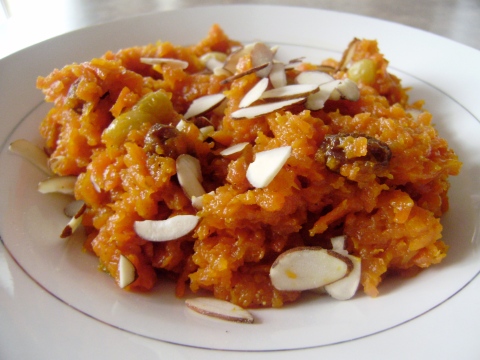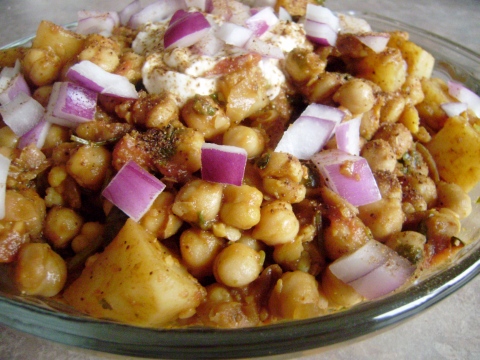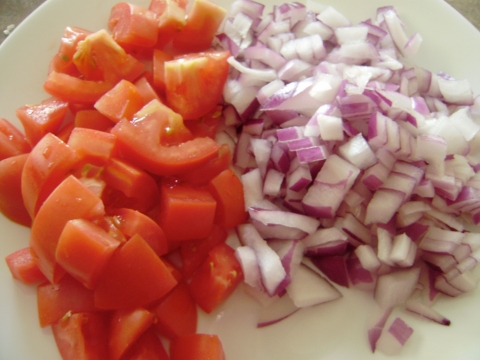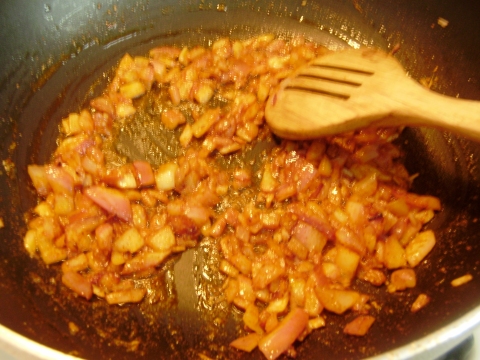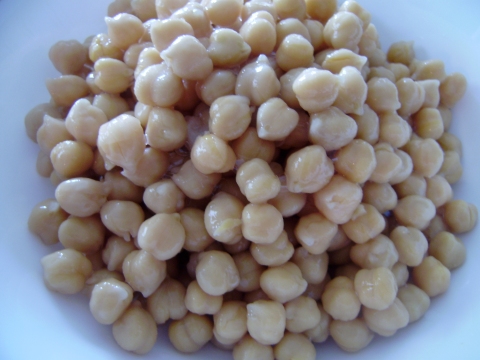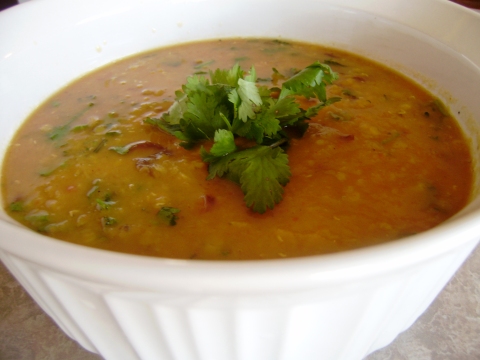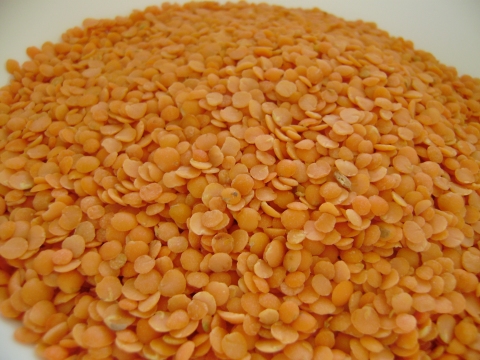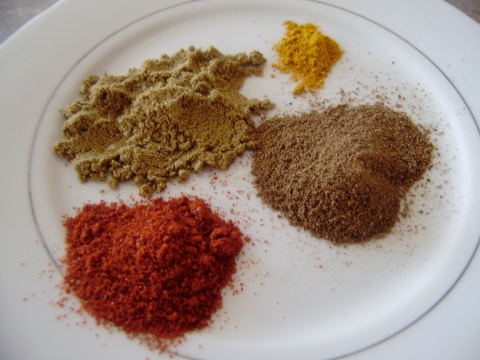Chicken 65
February 21, 2011
A name is important not only for people but for food as well. Deviled eggs, mud pie, babaganoush, gooseberries, ratatouille…just a few of the many interesting food names we encounter in our lives. I am always fascinated with how a dish is given it’s name because it plays a huge role in the overall appeal. However, there are several dishes we eat which have unusual names and yet we rarely stop to think about it… maybe because we are just as strange and weird as the food we eat :-)
Chicken 65 is an Indian dish which is particularly interesting because no one really knows where this name originated from. However, there are many theories:
- it was the year it was introduced
- its the number of days it took to prepare the marinade, but obviously after 65 days chicken will become …inedible!
- its the age of the chicken (65 days old)
- its the number of chicken pieces in the dish, but maybe cutting a chicken in 65 pieces would make it more like ground chicken than anything else.
- because India has so many chicken dishes, each dish is given a number instead of a name.
I don’t know how many other theories there are but those are the ones that I have heard the most. I’ll confess, I always thought it was because there were 65 ingredients in the dish …until I discovered that would be insane. But whatever it may be, this is an awesome dish. Originally it is pretty spicy and very red in color. However you can always control the spiciness to your taste.
There are two parts in making this dish. The first part is deep frying the chicken and the second part is combining it with the gravy. Both of which are listed in detail below, please use the spice measurements as a guideline as your taste may be less or more spicy than mine. Enjoy!
Chicken 65 Recipe:
To marinate the chicken-
- 2 lbs boneless chicken cut into pieces
- 1 1/2 tablespoons garlic and ginger paste
- salt as per taste
- 1/2 teaspoon black pepper
- 1/2 cup flour
- 1/2 cup corn starch
- 1 egg
- handful of chopped cilantro
- red pepper flakes as per taste
For the gravy-
- a bunch of curry leaves
- 3-4 slit green chilies
- 3 cups of yogurt
- 2 teaspoons red chili powder
- 1 – 1 1/2 teaspoons garam masala
- 1 teaspoons cumin powder
- 1 teaspoons coriander powder
- 1/2 teaspoon turmeric
- 1 teaspoon red color powder
- salt
Oil for frying*
First, mix the chicken with ginger and garlic paste, salt, and pepper. Marinate for an hour.
Next, add the flour, corn starch, egg, cilantro and pepper flakes to the chicken and mix very well so that all the chicken pieces are coated.
Drop the chicken pieces into heated oil, and deep fry until golden brown. Keep the friend chicken aside.
In a bowl, mix together the: yogurt, chili powder, garam masala, cumin, coriander, turmeric, red color, and salt to make a thick paste.
In a wok heat up a few tablespoons of oil and fry the curry leaves for 2 minutes. Then, add the yogurt paste. Cook for a few minutes stirring frequently. Add the cooked chicken pieces and mix well. Keep cooking until all of the sauce has been absorbed by the chicken. Add the green chilies and serve.
Gobi Manchurian
December 24, 2010
My “Winter Break recipes” officially start today. I finished my last exam on Monday and am determined to use this break to contribute some new recipes to my blog :) With all the exams and papers that I had these past few weeks I was finding no time to cook at all. In fact, the most cooking I did was make a bowl of cereal for breakfast.
I thought I would start off the winter recipes with a tribute to one of the best winter vegetables by far: cauliflower.
There are so many ways to make cauliflower, it’s popular in Indian food as well. A good example is Gobi Manchurian, although it is a mixture of Indian and Chinese cuisine, Gobi Manchurian is a very popular dish in India. In fact, I actually first had tried it when I was in India and liked it so much that I decided to re-make it at home.
I think overall, it’s really easy to make and it’s a great appetizer to have for a party. And of course if you’re a fan of cauliflower then I would definitely recommend trying this recipe.
Gobi Manchurian:
- 1 Medium cauliflower cut into florets
- 1 1/2 cups of flour
- 2 Tbsp corn flour
- water (to make paste)
- salt to taste
- red chili pepper to taste
- oil for frying
- 1 medium onion finely chopped
- 1 green chili finely chopped
- 2 teaspoons ginger and garlic paste
- A few tablespoons of soy sauce
- A few tablespoons of ketchup
- finely chopped cilantro for garnish
Make a paste out of the flour, corn flour, salt, red chili powder and water. Add enough water so that the paste is still thick enough to stick on to the cauliflower. Dip the cauliflower in the paste and fry in oil until golden brown. Keep aside when finished.
In a separate pan heat some oil and add the onions, garlic ginger, and green chili. Cook for a few minutes then add some soy sauce and ketchup in order to make enough sauce to coat all of the cauliflower. Add salt and chili powder to this as well to your taste.
Once the sauce is finished add in the fried cauliflower and mix well so that everything is coated. Garnish with cilantro and serve!
Butter Chicken!
November 23, 2010
Ahh I missed blogging these past few weeks! But it turns out things are very busy these days. Aside from school, work, and other side projects I have going on we are preparing for my sister in law’s arrival from India in 2 weeks. But, although my brother is hurrying to get everything settled before his flight on Thursday and my mom is in a frantic rush to perfect the house and my dad is rambling on about my mom’s frantic rush; we are all very very excited.
But getting back to the food, I haven’t posted anything in a while and the post for today is dedicated to any reader who has ever tried something at a restaurant and desperately had to recreate it themselves.
I think we have all been there. You go to a restaurant and have a dish that you can not stop thinking about. And eventually…attempt to recreate it. For me this was: butter chicken. I’ve had this dish in so many restaurants in both America and India and up until now I have never made it myself. The funny thing is I find myself doing this more and more when I eat something at a restaurant. I think of the ways that I could recreate that same dish with ingredients I’m familiar with. It’s actually really fun; kind of like solving a puzzle.
The recipe I used was basically this one by Mr. Sanjeev Kapoor. It’s a pretty darn complicated recipe so I tried to adapt it into simpler terms and I think it turned out really good; easy but still holds true to the butter chickeny goodness. Keep in mind you will need to alter the spice amounts to your taste, so think of this as just a guideline. Hope you like it!
Butter Chicken Recipe:
To Marinate the Chicken
- 2 lbs of chicken (cut into 2 inch cubes)
- 1 teaspoon red chili powder
- 1/2 teaspoon turmeric powder
- 2 teaspoons garlic and ginger paste
- 1 teaspoon salt
- 2 tablespoons lemon juice
To Make the Sauce
- 4 tablespoons butter
- 2 teaspoons garlic and ginger paste
- 4 green chilies (chopped)
- 1-2 teaspoons red chili powder
- 1 teaspoon salt (or to taste)
- 1/2 teaspoon dry fenugreek leaves (methi)
- 1 tsp garam masala
- 1 small cinnamon stick
- 28 oz can of tomato puree
- 1 cup of fresh cream
- handful of chopped cilantro
Marinate the chicken with all the ingredients listed for at least 1 hour.
Once it is done marinating, pan fry the chicken until very golden brown on all sides. Keep aside.
In a medium sauce pan heat butter until melted. Then add garlic/ginger paste and green chilies and cook for a few minutes. Then, add the red chili powder, salt, fenugreek leaves, garam masala, and cinnamon and cook for a few minutes. Next, add the tomato puree and bring to a boil. Finally add in the cream and honey and mix well, let this cook for about 5 minutes. Add the cooked chicken pieces and combine, garnish with cilantro.
Gajar ka Halwa (An Indian Carrot Dessert)
September 26, 2010
Gajar ka Halwa is a popular Indian dessert made of carrots, milk, sugar and dried fruit. It may be known as a carrot pudding…mainly because wikipedia said so and mainly because there really is no other way to describe “halwa” other than “pudding” even though it is not a pudding… it’s just pretty hard to translate.
Anyway, my mom used to make this dessert throughout our childhood on special occasions and me and my brothers love it, we could hardly wait before it was done and ready to eat. Often times I would “taste check” for my mom because of my impatience :)
Gajar ka Halwa can tend to be a heavy dessert, however throughout the years my mom has modified her recipe to make it lighter and a bit healthier with skim milk, less butter, and omitting ricotta cheese.
When I made this, I decided to add some fall flavors to it (nutmeg and cinnamon) and it turned out really nice. It’s one of those dishes that you can’t stop eating because hey, that is what happened to me so its bound to happen to you (side note: it’s really good when combined with vanilla ice cream.)
So I thought I would share the recipe with any of you who are interested in trying Indian sweets. Keep in mind this makes a whole pot of Halwa (enough for a party of 20 people) so you might want to halve the recipe and it will still be good.
Gajar Ka Halwa Recipe:
- 5lbs of carrots, peeled and shredded
- 2 sticks of butter
- 2 cups of skim milk
- 4 cardamoms, broken
- 1/2 cup almond powder
- 4 cups of sugar
- 1/2 teaspoon nutmeg (optional)
- 1/2 teaspoon cinnamon (optional)
- pinch of saffron mixed with 3 tablespoons of milk (optional)
- 1/4 cup of sliced almonds (for garnish)
- 1/3 cup of regular raisins
- 1/3 cup of golden raisins
Heat a large pot (such as a soup pot) and melt the butter. Add the shredded carrots and stir. Next add in the cardamom and milk and mix really well; you will need to cook this for 45 minutes stirring occasionally. This is the main cooking process of the halwa where the moisture of the carrots and the milk is absorbed.
Once the carrot is tender and everything has reduced add in the almond powder, sugar, nutmeg, cinnamon, and saffron mixture and stir well. Finally add in the raisins and mix. Cook for another 15-20 minutes.
Generally served warm with sliced almonds on top for garnish. :)
Cholay (Curried Chickpeas)
August 20, 2010
So, we are in the midst of Ramadan and I would just like to wish any Muslim readers a blessed Ramadan! All kinds of good eats are made during this month, makes me wonder why we don’t eat this food year-round but I guess that is what makes holidays so special: the atmosphere, the traditions, the food.
Yesterday I decided to make Cholay and it turned out especially good. I love making this dish because it is so easy. The whole thing is just chicpeas cooked with all kinds of good spices and you make everything in one pot which is my kind of cooking. Everybody makes Cholay differently and has their own variation of spices but nobody makes cholay like my mom. And… nobody will take her recipes and jazz them up except for me :) So here is my adapted version of “mummi’s cholay.”
Cholay Recipe serves 8-10 (you can easily reduce the recipe in half)
- 2 28oz cans of chickpeas, drained
- 2 medium tomatoes, diced
- 1 red onion, chopped (half reserved for garnish)
- 2 red potatoes, peeled and diced
- a few tablespoons of olive oil to cook everything
- 1/2 teaspoon salt (more or less to your taste)
- 1/2 a teaspoon chili powder
- 1/4 teaspoon turmeric
- 1/2 teaspoon of ginger and garlic paste
- 1/2 teaspoon cumin powder
- 1/2 teaspoon chaat masala (and extra for garnish)
- 1 teaspoon tamarind paste
- the juice of half a lemon
- 1/3 cup of water
- a handful of cilantro, chopped
Heat olive oil in a sauté pan or wok and fry half of the red onion until golden. Add tomatoes and cook until it becomes like a paste.
To the tomato and onions add ginger and garlic paste, chili powder, turmeric and salt…fry it well until you get a dark red color.
To the mixture, add diced potatoes and cook for about 10 minutes stirring occasionally. This will cook the potatoes about half way. Then add 2 cans of chic peas and stir until incorporated well with everything.
You will need to cook this for a while. Cover the pot with the lid and let everything cook, the potatoes are not fully cooked so this will take time; about 15 minutes. Give everything a big stir every now and then but keep the lid on.
Add the water, tamarind paste, lemon juice, cumin, chaat masala and last the cilantro– mix well! Check to see if the potatoes are done, if not keep cooking, if they are then turn off the heat.
How I served it: Pour it into a big platter, garnish with the other half of the red onion, a dollop of plain yogurt, and lots of chaat masala.
Daal
August 13, 2010
Dear reader, I thought it was about time I got an Indian recipe on here for your indulgence. I made Daal the other day because it had been a while since I last made it and (quite frankly) I was craving it like crazy. So I thought why not snap some pictures and add it to the blog.
A lot of the Indian food I make is based on what I see my mom do or based on what ingredients I feel like putting in the dish so that’s how this recipe came to be. This of course is one of the main reasons I love Indian cooking– there are so many spices that you can vary on, it’s the perfect opportunity to get creative.
Daal is often called a “lentil soup” because it is made of lentils and technically it is soupy, but Indians do not eat it as such. It’s usually eaten with bread or rice along side another dish (such as chicken or lamb) more like a gravy. It is a staple in every Indian household and is probably the easiest dish to make. A great place to start for beginners in Indian cooking.
There are several ways to make daal since there are so many different types of lentils you can use. This recipe calls for masoor daal which is red in color but other types are: channa, toor, moong, urad, etc… etc. It’s important to see what type of daal your recipe calls for because they vary in flavor, texture, and cooking times.
Daal Recipe:
- 1 1/2 cups of masoor daal (red lentils)
- 1 medium tomato, diced
- 1 teaspoon of garlic and ginger paste
- 1/4 teaspoon salt (more or less to taste)
- 1/2 teaspoon chili powder
- 1/4 teaspoon turmeric
- 1/2 teaspoon cumin
- 1/2 teaspoon garam masala
- 1 medium onion finely sliced
- water to boil lentils
- 1/4 cup olive oil
- a handful of fresh cilantro, chopped
Rinse lentils thoroughly and place in a medium saucepan along with tomatoes, garlic and ginger paste, salt, chili powder, turmeric, cumin, and garam masala. Cover with about 1 inch of water and bring to a boil. Reduce heat and simmer, stirring occasionally, until beans are tender and soupy about 20-25 minutes. (Add more water if it becomes too thick)
Meanwhile heat the olive oil in a frying pan. Add the onions and fry them until they are brown (but not burnt!) This will take a while, but just keep stirring it.
Add the fried onions and chopped cilantro to the daal and check to make sure it has enough salt to your taste. Serve with bread or rice.
The thing with daal is that its a dish that gets better and better the more you make it. Once you get a feel for it you will know how much of each spice you like and how long to cook it until its the perfect texture. I added the cumin and garam masala to it because it brings this depth of flavor thats really nice and warm. You could try adding your own spices and see how it turns out, be creative!



